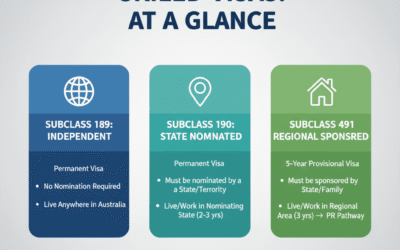Introduction
Australia’s Skilled Occupation List (SOL) 2025 sets out which jobs are currently in demand and which occupations qualify you for skilled migration visas. If your occupation appears on the SOL, and you meet other requirements like skills assessment, English proficiency, and points test, that opens doors to visa subclasses such as Subclass 189 (Skilled Independent Visa), Subclass 190 (State Nominated Visa), and Subclass 491 (Skilled Work Regional Visa).
This list isn’t just one uniform list—Australia classifies eligible occupations into the Medium- and Long-Term Strategic Skills List (MLTSSL), Short-Term Skilled Occupation List (STSOL), Regional Occupation List (ROL), and the newer Core Skills Occupation List (CSOL). These categories decide which visa options are open to you, whether you’re applying independently or with state nomination.
Why It Matters to Look at Each State
Each Australian state or territory maintains its own considerations when nominating occupations. Even if your occupation is listed nationally, state-by-state breakdowns matter because:
- Some states nominate occupations not listed (or more restricted) in the national SOL, depending on local labour market shortages.
- State nomination criteria may include extra requirements (like a job offer within the state, or specific experience relevant to that state).
- For visas like Subclass 190 or 491, state or regional nomination can help you gather extra points in the points test.
So, knowing the SOL for each state gives you insight into your realistic options, not just what’s possible in theory.
How This Guide Complements Other Resources
You already have access to broader information via the Skilled Visa Eligibility & Process Guide (2025)—that covers how you qualify overall, the visa process steps, and all eligibility criteria. This particular article—“Skilled Occupation List (2025) — Full Breakdown by State & Job”—works together with that Hub content by doing the heavy lifting on which occupations are accepted where, and how that affects your visa choices.
Use this SOL guide after you’ve reviewed eligibility and visa processes. It helps you map your occupation to the right state, understand which visa subclass you’re likely to qualify for, and plan your migration strategy with up-to-date occupation criteria.
Overview of Australia’s Skilled Occupation Lists
If you’re considering skilled migration to Australia, understanding the current occupation lists is one of the first and most important steps. These lists define which occupations are eligible under various visa subclasses and reflect what Australia needs in its workforce. In 2025, several lists like the MLTSSL, STSOL, and ROL — and the newer Core Skills Occupation List — determine not just whether your job qualifies, but how it qualifies for state nomination, regional visas, or permanent residency.
In the following sections you’ll learn:
- What each category (MLTSSL, STSOL, ROL, etc.) means and how it aligns to visa pathways (so you can see which options may be open to you).
- Why the changes made in 2025 matter — how labor shortages, policy shifts, and classification updates affect your chances and timing.
Categories Explained — MLTSSL, STSOL, ROL, and how they align with your visa options
Australia’s Skilled Occupation Lists define which occupations are currently in demand and which visa pathways you can use. The main lists are:
- MLTSSL (Medium- and Long-Term Strategic Skills List):
If your occupation is on the MLTSSL, you generally have access to more visa options—including permanent or near-permanent visas like subclass 189 (Skilled Independent), subclass 190 (State Nominated), and subclass 491 (Skilled Work Regional) among others. The MLTSSL focuses on occupations Australia needs for growth over the medium to long term. - STSOL (Short-Term Skilled Occupation List):
This list covers occupations that fill more immediate skills gaps. If your job is on the STSOL, you can often apply for visa subclasses that require state nomination or regional sponsorship (for example, subclass 190 or 491), but permanent residency routes may be more limited compared to MLTSSL occupations. - ROL (Regional Occupation List):
ROL includes additional occupations that are allowed for migration specifically into regional Australia. If you are willing to live and work outside the major metropolitan areas, ROL opens up opportunities (especially via subclass 491 or other regional visa streams) which might not otherwise be available to you under the national lists.
These lists map onto visa subclasses differently:
- If your occupation is on MLTSSL, you often get the widest set of visa choices, possibly including direct permanent residency.
- If it’s on STSOL, you might still get permanent pathways—but often you need state/territory nomination or meet regional criteria.
- If it’s on ROL, your pathway is likely regional-focused and may require extra points or regional work commitments.
Also, note: the Department of Home Affairs maintains a combined Skilled Occupation List which shows whether a given profession is on the MLTSSL, STSOL, ROL, or the new Core Skills Occupation List (CSOL).
Why the 2025 Updates Matter — labour shortages, policy shifts, and what that means for your planning
Here’s what’s new in 2025, and why these changes are important if you’re planning your migration based on the Skilled Occupation List:
- Introduction of CSOL / Review of Lists:
The 2025 reforms introduce or strengthen the Core Skills Occupation List (CSOL). Jobs and Skills Australia is consulting on this list, which will refine which occupations are truly in demand and how they align with Australia’s long-term migration and labour market strategy. - Alignment with Labour Market Shortages:
Australia’s occupation shortage data (via Jobs and Skills Australia’s Occupation Shortage List (OSL)) is increasingly being used to shape which occupations enter or exit the lists. If an occupation is in shortage in your desired state or region, that improves your chances of nomination or selection. - Policy reforms to visa and migration strategy:
The Migration Strategy released in late 2023 sets out that migration settings will more tightly match workforce needs — not just in major cities, but also in regional areas. That means ROL and state/territory nomination rules are more important than ever in your planning. - Use of updated classification systems:
The shift toward updated occupational classification (for example, moving from older ANZSCO versions to newer versions, and comparing with international obligations) means your occupation might change classification, or its eligibility status might shift. You should always check the latest version of ANZSCO/OSCA and the current legislative instrument. - Strategic timing & competitiveness:
Because occupations are reviewed and updated, what qualifies today might not tomorrow. If your occupation is on the cusp (or recently added or removed), applying earlier may give you an advantage. Also, some visa streams now emphasize state/territory nomination, regional work, or extra points. These are practical levers you can work on.
State-by-State Skilled Occupation Breakdown
As you move from understanding the national Skilled Occupation List (SOL) categories to the state-level breakdowns, this section will help you see exactly how each Australian state and territory applies the SOL in practice. You’ll learn what occupations each state currently nominates under its Subclass 190 and 491 pathways, whether those roles align with MLTSSL, STSOL or regional-list priorities, and how often states update their nomination lists.
This will let you map where your occupation has the strongest chance in your migration strategy.
New South Wales (NSW)
| Category | Details |
| Nomination approach | NSW offers nomination for Subclass 190 (Skilled Nominated) and Subclass 491 (Skilled Work Regional) visas. You must submit an Expression of Interest (EOI) via SkillSelect, and NSW issues invitations; you cannot apply directly for nomination. |
| Update timing & priority sectors | NSW Skills Lists are maintained at the ANZSCO unit-group level; however, not all occupations in a listed unit group are eligible. The lists are updated periodically. Critical skills are aligned with NSW’s economic priorities. |
| Official sources | NSW Government site: NSW Skills Lists page; Skilled Nominated visa (Subclass 190) page; Skilled Work Regional visa (Subclass 491) page. |
Eligible Occupations by Pathway (very brief examples):
- MLTSSL-like roles: Many of the occupations nominated by NSW for 190 are high-skill, long-term demand roles (e.g. Construction Managers, Engineering Managers, ICT Managers). (NSW Government)
- STSOL-like / Trades roles: NSW also lists trade and technician unit groups (e.g. Electricians, Carpenters, Motor Mechanics) especially in the Regional Skills List for 491. (NSW Government)
- Regional / ROL-type roles: Through the NSW Regional Skills List (for Subclass 491), certain occupations in regional NSW are eligible; plus special pathways for regional graduates. (NSW Government)
Quick Tips:
- Check whether your occupation is in a relevant ANZSCO unit-group listed in NSW’s Skills Lists; then verify whether your specific occupation is eligible under that unit group. (NSW Government)
- If you’re aiming for Subclass 491, see whether your location (or study) qualifies as regional NSW, as that affects eligibility and priority. (NSW Government)
- Be aware of invitation rounds — NSW selects EOIs based on several factors (age, English, work experience, points). Strong overall EOI helps. (NSW Government)
- Make sure your skills assessment is current and matches the nominated occupation. Without that, even if your occupation is listed, your nomination can’t proceed. (NSW Government)
Victoria (VIC)
| Category | Details |
| Nomination approach | Victoria uses a Registration of Interest (ROI) process via Live in Melbourne, plus EOI via SkillSelect, for Subclass 190 and Subclass 491 nomination. |
| Update timing & priority sectors | Victoria has closed its 2024-25 ROI window (as of 29 April 2025) for new applications. Priority sectors include healthcare, social work, education, and construction. |
| Official sources | Victoria Government Skilled Visa Nomination pages; “Live in Melbourne” portal. |
Eligible Occupations by Pathway:
- MLTSSL Roles: Many health-profession jobs and engineering roles are considered under Victoria’s scheme (e.g. early childhood teachers are explicitly named). (Victoria Government)
- STSOL Roles: Some occupations in hospitality, community services etc., especially for regional nominations. (GetGIS)
- Regional / ROL-type roles: Victoria gives weight to regional applicants and reserving some nomination places for regional work; regional visas (Subclass 491) are part of the program. (Victoria Government)
Quick Tips:
- Check whether your occupation is listed under Victoria’s priority sectors. If you’re in a high-demand sector (health, education, construction), you have a better chance.
- Make sure you submit or have submitted the ROI before the closing date (for current program year). If the program is closed, you must wait for the next year.
- Confirm your occupation’s ANZSCO code and compare it with Victoria’s nominated occupations.
- If you plan regional living/work, find out if your nominated job qualifies under “regional” criteria in your location.
Queensland (QLD)
| Category | Details |
| Nomination approach | Queensland’s Skilled Visa Nomination program runs for Subclass 190 and 491; uses the QSOL (Queensland Skilled Occupation List). |
| Update timing & priority sectors | For 2024-25, Queensland has been allocated 1,200 nomination places — 600 for Subclass 190 (permanent), 600 for 491 (regional). Key sectors include energy, construction & infrastructure, healthcare & social assistance. |
| Official sources | Queensland Government’s migration/nomination portal; QSOL published by Migration Queensland & Home Affairs. |
Eligible Occupations by Pathway:
- MLTSSL Roles: Many healthcare, engineering, and technical professions are included in QSOL, especially those on Home Affairs’ national eligible occupation list.
- STSOL Roles: Some service, trades or community work make up a portion (especially for 491 nomination) when there is short-term demand.
- Regional / ROL-type roles: Regional 491 nominations in Queensland get priority; if you live/work in regional areas your occupation may get more weight.
Quick Tips:
- Use the QSOL tool to see whether your job matches the ANZSCO code and whether it’s included in the 190 or 491 stream.
- Be aware of competition—if your occupation isn’t in a priority sector, you’ll likely need stronger points, experience, or partner skills.
- Understand what “regional work requirements” are in QLD; might help boost your case.
Western Australia (WA)
| Category | Details |
| Nomination approach | WA uses WASMOL (Western Australia Skilled Migration Occupation List) with separate Schedules (Schedule 1, Schedule 2) plus a Graduate Occupation List (GOL). Streams cover Subclass 190 and 491. |
| Update timing & priority sectors | For 2024-25, WA’s State Nominated Migration Program is in operation; invitations are issued monthly in many cases. Priority sectors: building & construction; healthcare & social assistance; education & training; hospitality & tourism. |
| Official sources | WA Government Migration Services site; WASMOL & GOL lists. |
Eligible Occupations by Pathway:
- MLTSSL Roles: WA includes many professions that align with national MLTSSL—healthcare professions, engineers, etc.
- STSOL Roles: Some trades and vocational roles under WASMOL schedule 2 and other occupation lists; these become more relevant for regional or construction sectors.
- Regional / ROL-type roles: WA provides regional priority in many streams; some WASMOL occupations are flagged “regional WA only.” If your intended location is regional, check whether your occupation is eligible under “Regional WA Only.”
Quick Tips:
- Verify whether your occupation is on WASMOL Schedule 1 or 2 vs Graduate list, as requirements differ.
- You may need a work contract for certain occupations, especially under the General stream. Check specific WA list requirements.
- Always check if “regional” eligibility applies to your location. Some occupations might be limited to regional WA.
- Make sure your skills assessment matches exactly your nominated occupation, per WA’s rules.
Tasmania (TAS)
| Category | Details |
| Nomination approach | Tasmania uses the Tasmanian Skilled Employment pathway and the Tasmanian Onshore Skilled Occupation List (TOSOL). For Subclass 190 nomination, there are two options: TOSOL option and Long-Term Employment option. |
| Update timing & priority sectors | The 2025-26 program settings are not yet finalised as of the latest update. There is a “critical roles list” and new priority attributes that affect which occupations are favoured. |
| Official sources | Migration Tasmania site for TOSOL and Skilled Employment pathways; “Tasmanian Skilled Employment Pathway” pages. |
Eligible Occupations by Pathway:
- MLTSSL Roles: Many occupations that fall under national MLTSSL are part of the TOSOL if they meet the caveats (e.g. long-term demand fields, health, engineering, ICT).
- STSOL Roles: There is less clarity; STSOL-type occupations may be eligible under certain pathways (especially with long-term employment), but generally the focus is on more highly skilled/priority roles.
- Regional / ROL-type roles: Since Tasmania is relatively regional by nature, many of its nomination pathways favour applicants who live/work there and committed to continuing in TAS. Also, the TOSOL list includes occupations that may grant nomination after shorter employment stints. (migration.tas.gov.au)
Quick Tips:
- Check whether your occupation is listed in TOSOL and if there are any caveats or priority attributes (Gold, Green, Orange-Plus).
- If your job isn’t on TOSOL, see whether the Long-Term Employment option allows it via related ANZSCO group plus required employment history.
- Make sure your employment hours and working period in Tasmania meet the requirements (often 6 months at 20 hours/week under TOSOL; longer for other streams). (migration.tas.gov.au)
- Watch for the opening of the 2025-26 program—new registration windows and updated policies (selection criteria, priority zones, etc.) may change things.
Australian Capital Territory (ACT)
| Category | Details |
| Nomination approach | ACT uses a Critical Skills List to define occupations in demand. To apply for ACT nomination (Subclass 190 or 491), you usually have to satisfy criteria via the Canberra Matrix, which awards points based on occupation, location, commitment etc. |
| Update timing & priority sectors | The ACT Critical Skills List was last updated on 18 April 2023. Updates are generally annual. (ACT Government) Key occupations in demand include (but not limited to) roles like Construction Project Manager, Project Builder, Engineering Manager, Health & Welfare Services Managers etc. |
| Official sources | ACT Government — ACT Critical Skills List, ACT Skilled Migrants pages. Canberra Matrix info from ACT site. |
Eligible Occupations by Pathway:
- MLTSSL Roles: Many ACT priority occupations are high-skill (skill level 1 or 2 in ANZSCO), so overlap strongly with MLTSSL occupations. Examples: Engineering Managers, Finance Managers.
- STSOL Roles: There may be fewer STSOL-type occupations in ACT’s list, since ACT tends to emphasise high-skill and strategic demand roles.
- Regional / ROL-type roles: ACT is mostly urban, so “regional” emphasis is less. The 491 pathway in ACT has criteria but fewer “regional only” roles as compared to states with large rural/remote areas.
Quick Tips:
- Use the ACT Critical Skills List to check whether your occupation is in demand. If it is, that can help with both nomination and boosting points via the Canberra Matrix.
- Be aware of caps: ACT may cap the number of nomination places for certain occupations. If your occupation is capped, there might be a waiting period before you can be invited. (ACT Government)
- Check the ACT criteria for your visa subclass (190 or 491) together with Canberra Matrix; it’s not enough just to have the occupation—it often requires meeting other commitments.
Northern Territory (NT)
| Category | Details |
| Nomination approach | NT has a Skilled Occupation Priority List (NTSOPL) or “Hard to Fill Jobs” list, which highlights occupations with shortages or priority status. This list can influence migration/employment opportunities and state nomination. |
| Update timing & priority sectors | The NT list is updated annually; the most recent “Hard to Fill Jobs” list was released 27 June 2024. (NT Government) Key priorities include engineers (civil, electrical, structural etc.), managers, surveyors, early childhood, environmental and regional planning roles. |
| Official sources | NT Government — “Hard to fill jobs in the NT” page; NT Government’s Skilled Occupation Priority List PDF. |
Eligible Occupations by Pathway:
- MLTSSL Roles: Many occupations on NT’s priority list are high skill (engineering, surveying, management), which correspond to the MLTSSL list.
- STSOL Roles: There may be fewer STSOL-type occupations singled out; focus is more on occupations that have critical or long-term shortage.
- Regional / ROL-type roles: Many of NT’s “hard to fill” roles are in remote or regional areas; living/working in regional NT or being associated with an occupation priority can strengthen your chances.
Quick Tips:
- Check whether your occupation is listed among the NT priority occupations (Hard to Fill Jobs). If so, it may give you an advantage for state nomination or employer sponsorship.
- Use your ANZSCO code to confirm exact match—sometimes unit groups are broad, but only specific occupations are high priority.
- If you intend to live/work in regional NT, see whether there are extra incentives or priority for remote areas for your occupation.
- Be proactive: these priority lists are maintained and can shift with market demand, so double-check when preparing your application.
Comparing Across States: Key Insights
When you compare state skilled occupation lists and labour market trends, a few clear patterns emerge. These give you useful signals about where demand is strongest, where specific niches offer higher opportunity, and where shortages are driving priority migration.
Common High-Demand Occupations — Nursing, Engineering, IT, etc.
You’ll find that across most Australian states, some occupations show up again and again in demand. These are typically in healthcare (especially nursing and allied health), engineering (civil, mechanical, electrical), and information technology (software, systems, cybersecurity).
- The 2024 Occupation Shortage List (OSL) confirms that registered nurses and health professionals are persistently undersupplied.
- In IT: roles like software & applications programmers, systems analysts & cybersecurity specialists are frequently identified among high-growth occupations.
- Engineering: civil engineering professionals, electrical engineers, mechanical engineering (and maintenance) roles are often flagged in both national and state shortage-analyses.
What this means for you: if you’re qualified in any of these areas, many states are likely to accept your occupation under the SOL / state nomination lists. Just check whether your specific ANZSCO code is listed, and whether the skills/experience match.
For more details – https://www.jobsandskills.gov.au/sites/default/files/2024-10/2024%20OSL%20Key%20Findings%20and%20Insights%20Report%20%E2%80%94%20Appendices%20(1).pdf
State-Specific Priorities — e.g., WA’s Mining Focus, SA’s Health/Trades Emphasis
Each state also has its particular strengths or “special needs,” depending on local industries, demographic pressures, and major projects. Recognizing those helps you pick which state might be more welcoming for your occupation.
- Western Australia (WA): WA has a severe mining workforce shortage. More than 11,000 new workers will be required by around 2029 to support proposed resource-projects. Roles in demand include mining engineers, geologists, heavy equipment operators, electrical & mechanical maintenance technicians.
- South Australia (SA): SA is focusing heavily on health, trades, professional services, and technology. For example, SA’s Jobs & Skills Outlook 2024 reports strong growth projected in health care (registered nurses, allied health‐professionals), software and applications programming, electricians, carpenters, and truck drivers.
So, if your trade is in construction, or you are a nurse or engineer, you’ll want to see which state-specific lists and nomination criteria best match your skills. Sometimes a less obvious state may offer more chances because of its local priorities.
Addressing Construction Skills Shortages — Context and Implications for Aspiring Migrants
Construction trades consistently show up in state and national shortage lists. This includes bricklayers, carpenters, joiners, plumbers, electricians, and technical roles related to civil construction. The shortage persists because many of these jobs require hands-on experience, apprenticeship training, and often working in regional or remote areas.
Context:
- According to the Jobs and Skills Australia report, Technicians and Trades Workers face especially high vacancy fill-rate challenges. Many of these roles are being under-staffed, particularly in regional areas.
- In WA, construction trades are in demand to support both mining infrastructure and general building needs. The Building & Construction Occupations list for WA includes bricklayers, plumbers, electricians, and many trade roles as eligible under employer-sponsored, state-nominated visas. (migration.wa.gov.au)
Implications for you:
- If you’re a tradesperson with a Certificate III or IV (or equivalent), you may meet the requirements for many state nomination streams, especially under the SOL, STSOL, or ROL lists.
- Regional or less popular states may give extra benefit or faster nomination if your trade is in high demand there.
- Be ready for requirements related to experience (often 2-3 years), licensing, and sometimes working in regional areas. For some trades, being able to show hands-on work or proof of apprenticeship can be critical.
Tools & Resources for Users
When you’re using the Skilled Occupation List (2025) and comparing state-by-state job demand, these tools and resources help you verify facts, avoid mistakes, and plan your migration more intelligently.
Official Government Sources
To make sure your migration plan is accurate, always rely on government sources. These are updated regularly and carry legal weight when confirming which occupations are eligible, what ANZSCO codes apply, and how visa eligibility works.
- Department of Home Affairs – Skilled Occupation List
This is the core list showing which occupations are eligible under the MLTSSL, STSOL, and ROL categories. It also includes the ANZSCO codes (occupation classifications) and the assessing authority for each occupation. When you check whether your occupation is eligible for visas like subclass 189, 190 or 491, start here. (Immigration and citizenship Website) - Core Skills Occupation List (CSOL) via Home Affairs / Jobs and Skills Australia
CSOL gathers occupations identified as priorities by government bodies and gives insight into sectors Australia considers essential right now. Use this list to spot what jobs the government is actively encouraging or likely to support. (Immigration and citizenship Website) - State & Territory Migration Portals
For example, Tasmania’s Tasmanian Onshore Skilled Occupation List (TOSOL) shows which jobs are eligible for nomination in Tasmania under subclass 190. (migration.tas.gov.au)
South Australia’s Skilled Occupation List is another good example, and it allows you to search by occupation name or ANZSCO code in your state. (Move to South Australia)
If you plan to live or work in a particular state, double-check their nominated lists. Sometimes what’s eligible nationally isn’t accepted for state nomination. - Jobs and Skills Australia data & reports
This source provides labour market trends, occupation profiles (ANZSCO data), data on skills shortages, and insights that help you understand which occupations are likely to remain in demand. It helps you look ahead. (Jobs and Skills Australia)
Expert Support – Blue Orbit Services
While government sources give you official rules and data, migration policies can be complex—interpreting them correctly can make a difference. That’s where professional help can elevate your chances and reduce risks. Blue Orbit Services offers that support.
- What Blue Orbit Does Best:
Blue Orbit provides end-to-end migration and business services. Whether you need help with skilled migration, international student visas, employer sponsorship, or parent visa applications, they guide you at each step.
They also handle visa cancellation or review matters, in case your situation changes after you apply. - Personalized Guidance with Expertise:
Their team includes registered migration agents (with official numbers) and lawyers experienced in Australian migration law. They can help you interpret which occupations on the SOL/CSOL match your education and work experience, what ANZSCO code to apply under, and which state’s nomination list would give you the best advantage. - Reducing Risk & Saving Time:
By working with Blue Orbit, you avoid common pitfalls: misidentifying your occupation, missing a required assessment by an authority, or being unaware of state-specific nomination caps. They streamline your documentation, monitor changes in SOL, and help you choose the best visa subclass strategy (189/190/491) based on your occupation’s status.
Strategic Tips for Applicants
- See where your occupation is in demand — If your job figures on a state nomination list (SOL, STSOL or regional), that state may give you priority.
- Compare living costs quickly — Rental, groceries, utilities vary a lot by city. For example, Sydney’s rent is ~ 48 %+ above the Australian average for inner-city one-bedroom units.
- Think lifestyle trade-offs — Big cities have more work opportunities & amenities; regional/rural areas offer lower cost of living and more space.
- Check long-term growth & regulation in your field — Some states have growth in sectors you care about (like healthcare, construction, tech), or require special licensing.
- Estimate how much you’ll keep after expenses — A slightly lower salary in a cheaper state may leave you better off overall once rent, food, transport are factored in.
Summary & Next Steps
You’ve now seen how the Skilled Occupation List (2025) works—how occupations are categorized (MLTSSL, STSOL, ROL), how state-by-state breakdowns differ, and what occupations are commonly in demand. Understanding this list helps you align your skills, experience, and location preferences with the visa pathways that are most likely to succeed.
Here are concrete steps you can take now to move forward with confidence in your skilled migration journey:
What You Have Learned
- The Skilled Occupation List determines which occupations are eligible for different visa subclasses (such as 189, 190, 491).
- Each state or territory maintains its own version of the occupation list, often adding occupations of particular local demand that may not appear on the national list.
- Recent policy reforms (like the new Core Skills Occupation List (CSOL) / Skills in Demand visa) are reshaping how Australia assesses demand and eligibility for skilled migration.
Your Next Steps
- Check Your Occupation & Skills Assessment:
- Find the ANZSCO code for your occupation. Make sure your occupation appears under relevant SOL categories (MLTSSL, STSOL, ROL or CSOL).
- Verify which assessing authority evaluates your occupation (engineering, nursing, trades, etc.).
- Decide Where You Want to Be Based:
- Compare state-by-state skilled occupation lists. A role listed in one state but not another can affect your nomination options and visa subclass eligibility.
- Consider the cost of living, job market demand, and lifestyle of each state.
- Match Your Visa Subclass:
- Based on your occupation and state, see whether subclass 189, 190, 491 (or others like Skills in Demand visa) fits you best.
- Use your points score, eligibility, and state nomination requirements to decide the best path.
- Gather Necessary Documentation:
- Ensure your qualifications, work experience, English proficiency, identity documents, and any registration/licensing are ready.
- If your occupation has special requirements or caveats, satisfy those early.
- Stay Updated with Government Changes:
- Policy reforms, list updates, and visa subclass amendments happen. Check the Department of Home Affairs site for the current Skilled Occupation List, CSOL, etc.
- Be aware of upcoming deadlines or consultation periods (for example, consultations for the 2025 CSOL) so that you can provide input or adjust if needed.
How Blue Orbit Services Can Help You
If you feel uncertain at any of these steps, Blue Orbit Services offers personalized guidance. They help you:
- Assess your occupation’s eligibility and interpret how your skills match SOL / CSOL criteria.
- Choose the best state or territory based on your job, lifestyle, and visa subclass targets.
- Prepare and submit your visa application, ensuring all documents meet the requirements.
Working with experts can reduce risk, avoid errors, and improve your chances of approval.
Your Migration Plan: Putting It All Together
Here’s a mini-checklist you can follow to streamline your path:
| Step | Action |
| 1 | Identify your occupation’s ANZSCO code and list category. |
| 2 | Research state occupation lists and nomination criteria. |
| 3 | Decide on your visa subclass (189, 190, 491, Skills in Demand, etc.). |
| 4 | Calculate your points and ensure you meet the threshold. |
| 5 | Gather credentials, proof of experience, English tests, etc. |
| 6 | Submit your Expression of Interest (EOI) if required. |
| 7 | Apply and monitor your application; stay alert for list changes or policy updates. |
You’re in a strong position now: you understand how the Skilled Occupation List shapes visa eligibility, which states might favour your occupation, and what you need to do to act next. When you apply these steps, you make your migration journey far more strategic and likely to succeed.

About the Author:
Kunal is an Australian Solicitor with over 10 years of legal experience in both Australia and abroad. Admitted to the Supreme Court of Victoria, he uses his unique background to help businesses, professionals, and individuals with their legal, commercial, and migration needs.




